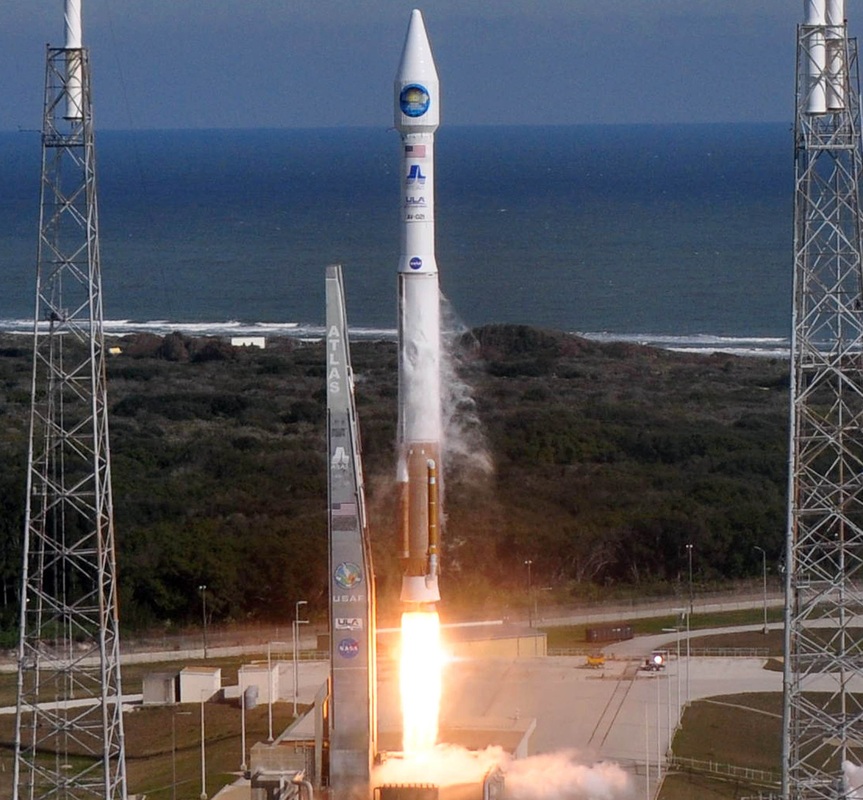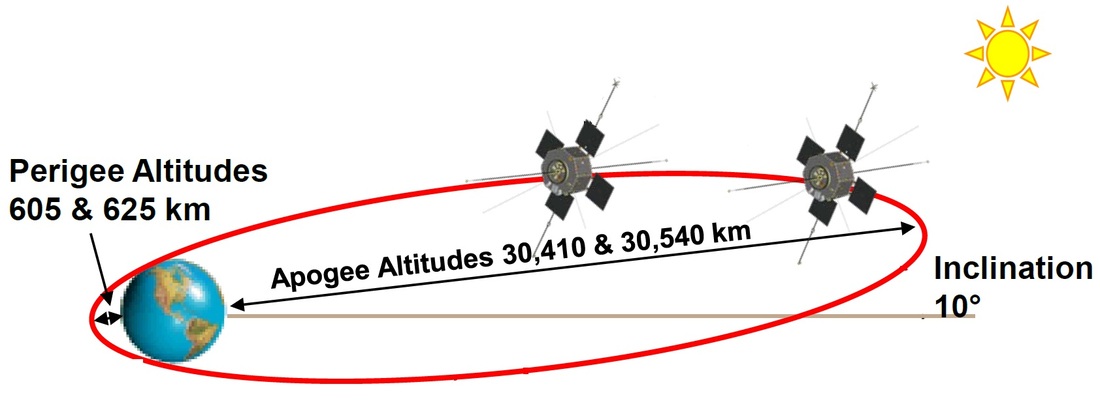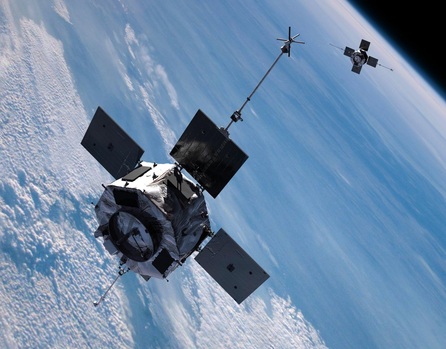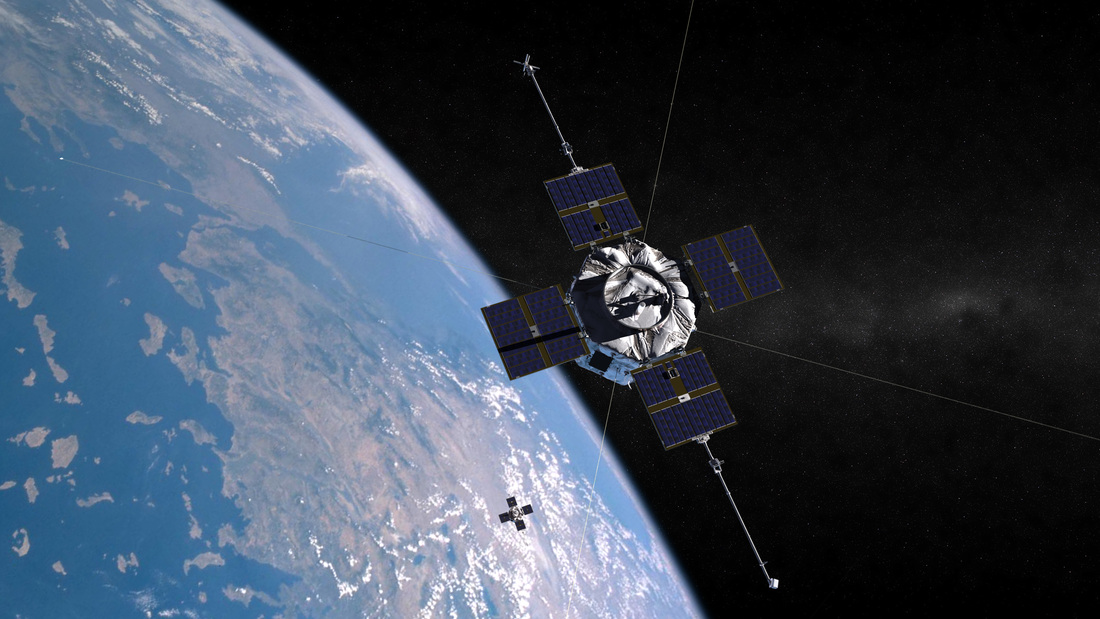Mission Desgin & Timeline
Launch Phase

The twin RBSP Spacecraft are being Launch atop an Atlas V 401 Launch Vehicle operated by United Launch Alliance which will deliver the twin Spacecraft into their Transfer orbits. RBSP begins its Launch Phase when transitioning to the Launch Configuration just before Liftoff from Space Launch center 41 at Cape Canaveral Air Force Station. Atlas V 401 features no Solid Rocket Booster, a single Engine Centaur Upper Stage and a 4-meter Payload Fairing. A full Launch Vehicle Overview can be found here. The Atlas V Launcher completes a nominal ascent mission consisting of a normal burn of the Common Core booster First Stage, followed by an initial burn of the Centaur Upper Stage to place the stack in a Low Earth Parking Orbit. After a short Cruise Phase, Centaur makes another burn to raise the Apogee of the orbit to its desired level. The Upper Stage conducts a spin-up maneuver and sends the two spacecraft on their way, separating within a short time of each other. After the release, the twin vehicles will move apart from each other and enter their final and operational orbits.
Target Orbits
The RBSP A and B Spacecraft are targeting nearly identical orbits. One Vehicle will fly in a 605 by 30,140 Kilometer Orbit while the other vehicle targets a 625 by 30,5440-Kilometer Orbit. These slightly different apogees allow simultaneous measurements to be taken over the full range of observatory separation distances several times over the course of the mission. One observatory laps the other every 75 days in the desired orbits. Each orbit has an inclination of 10 degrees to either side of the equator. The orbital period is about 9 hours. The target orbits result in the Spacecraft spin axis being located 15 to 27 degrees off the sun angle. The vehicles are spin stabilized and target a spin rate of 5rpm after commissioning is complete.


Commissioning Phase
Immediately after orbital insertion, the mission transitions to its 60-day Commissioning Phase. The RBSP Spacecraft deploy their four solar arrays shortly after launch. With the Deployment of the solar arrays, the twin Magnetometer Booms mounted on two opposing arrays, can be extended to set the stage for magnetometer activation and checkouts. All science instruments are activated following launch and begin an extensive checkout and calibration period. Initially, instruments that have to be deployed are checked in their stowed configuration before being deployed. The four radial and twin axial booms are deployed over a two-week period. As the pair-wise boom deploy sequence unfolds, the spin rate of the spacecraft decreases and can be used as a measure of state of deploy and abort criteria. The booms are deployed in a click-wise fashion with one boom boom staying within 2 clicks of the opposing one. After Radial Boom Deployment is complete, the twin axial booms are deployed to their initial 5-meter deploy state. The final deploy lengths are trimmed in centimeter increments. This fine tuning occurs in parallel with other commissioning activities.
During the Commissioning phase, orbit adjustment maneuvers are performed to place the RBSP Spacecraft in their final orbits and into proper respective trajectories to one another. Spacecraft commissioning is planned to be completed by L+60 days and has to be complete by L+71 days for the first observatory overlap.
Science Phase
The Science phase of the RSP Mission begins once both vehicles have completed their respective Commissioning Processes. The primary mission has a duration of two years, but there is the possibility of extending the science mission by additional two years based on spacecraft performance and science return. During the Science Mission, the RBSP Spacecraft will undergo regular attitude maneuvers. Every 21 days, the twin spacecraft will undergo a re-orientation maneuver to maintain the proper sun angle of the vehicle’s solar arrays as the orbit of the vehicles constantly changes the sun angle. During the orbit’s evolution, North-South Angles drift from 15.4 to 22.6 degrees and East-West Angles move from 8 to 15.2 degrees. Sun angles have to be maintained within that corridor to ensure sufficient power supply. Attitude maneuvers are planned by ground teams by using information by the sun sensor of each spacecraft. While the science mission is in progress, the A and B spacecraft will lap the other once every 75 days.

Communications
The RBSP Spacecraft feature communication systems that are capable of communicating with ground stations as well as NASA’s tracking and Data Relay Satellite System. TDRSS will be used during critical Mission Events such as Launch and Ascent. During the Mission, the primary Ground Station for all communications including telemetry and science data downlink as well as command uplink is the Applied Physics Laboratory Ground Station at Johns Hopkins University. Other Commercial Ground Stations can be called up based on downlink requirements and as back up for the primary station. Spacecraft data and telemetry is relayed to the Mission Operations Center which then sends the Instrument Data to the appropriate Science Operations Centers for the five instruments.
The Science Operations Centers are responsible for data processing and analysis as well as command generation. Commands are sent from the individual Science Operations Centers to the Mission Operations Centers where they are prepared for uplink to the Spacecraft.
Data Processing
Data acquired by the individual RBSP is stored aboard the vehicle before being downlinked to the Mission Operations Center which then relays the data to the Science Operations Center for each of the instruments. This L0 Data is in binary format and data volume varies between the different instruments: ECT: 450MB/day – EMFISIS: 500MB/day – EFW: 130MB/day – 414MB/day – RPS: 50MB/day. At the Science Operations Center, initial data processing takes place to achieve L1 Level Data which is larger in volume and includes CDF or CSV formatting. Also, L1 data includes sorted elements and count rates. For some instruments, L1 data is available within 8 hours, but for others L1 data will be available 14 days after receipt. L2 data products include calibrated data and initial analysis and is available 1 month after acquisition. L3 data includes in depth data analysis with additional values gained from raw data. Also, events are time-stamped, calibrated and all background noise is removed. L4 data products are high level data sets that include global maps, phase space density data as well as in depth analysis. L4 data is available after one year of data processing for all instruments, except RPS for which L4 Data in the form of Global Maps is available within 9 days.
